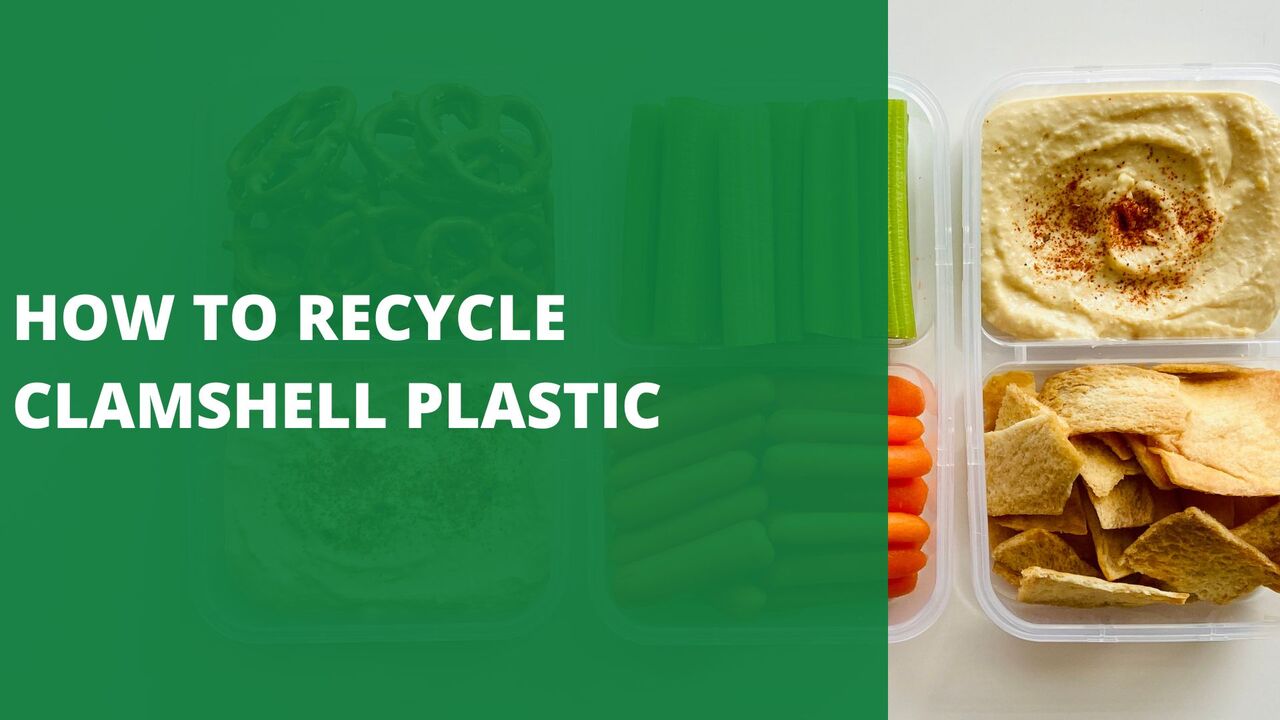Many clear plastic containers from berries or salads seem recyclable, but they can be difficult to process. While they are technically recyclable, some programs don’t accept them due to sorting challenges. With a little knowledge, you can still make a difference in reducing plastic waste.
This guide will help you understand how.
- Why these clamshell plastics are so tricky to recycle
- How to spot the ones that can go in the bin
- Some cool alternatives to try
- How your choices can push for greener packaging
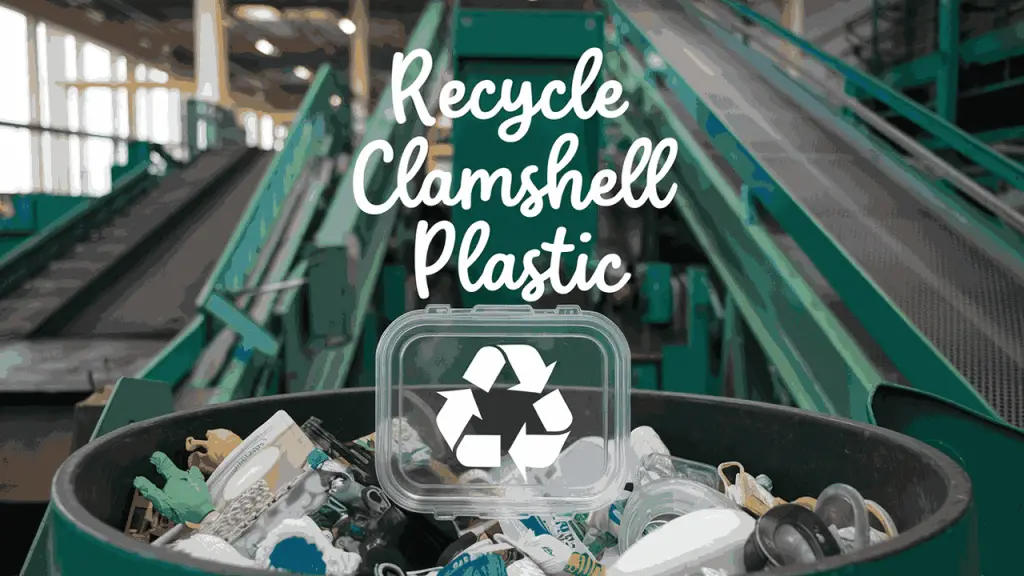
Understanding Clamshell Plastic
A. Definition and common uses
You’ll find clamshell plastic containers in grocery stores, housing berries and salad greens. These lightweight, durable packages are made from polyethylene terephthalate (PET), typically marked with a #1 symbol.
Clamshells are also common in restaurant takeout, protecting your food during transport.
B. Manufacturing process: Thermoforming vs. Blow molding
| Process | Method | Product |
| Thermoforming | Heat and mold plastic sheets | Clamshells |
| Blow molding | Inflate heated plastic | Bottles, jugs |
You should note that these different processes result in PET products with varying grades, all 100% recyclable in theory.
However, the differences create challenges in recycling clamshells, which we’ll explore in the next section on “Challenges in Recycling Clamshell Plastic.”
Challenges in Recycling Clamshell Plastic
Let’s delve into the challenges you’ll face when trying to recycle these containers.
A. Differences in PET grades
Clamshells are made through thermoforming, while bottles use blow molding. This results in varying PET grades, all recyclable but with distinct properties:
| Property | Clamshells | Bottles |
| Density | Lower | Higher |
| Melting point | Different | Standard |
| Processing | More fine particles | Less fine particles |
B. Sorting difficulties at recycling facilities
You’ll find that clamshells cause sorting issues at Material Recovery Facilities (MRFs):
- Lightweight design makes them behave like paper on conveyor belts
- Only about 11% of MRFs can process clamshells
- Mixing with bottles compromises recycled material quality
C. Contamination issues in PET bales
Clamshells often contain strong adhesives, leading to:
- Complications in the recycling process
- Contamination of PET bales
- Reduced market value for recycled materials
D. Limited acceptance in recycling programs
Despite being recyclable, many programs don’t accept clamshells due to these challenges. You’re advised to:
- Keep clamshells out of recycling bins if not accepted locally
- Seek alternative recycling solutions
- Consider avoiding products with clamshell packaging
Proper Recycling Process for Clamshells
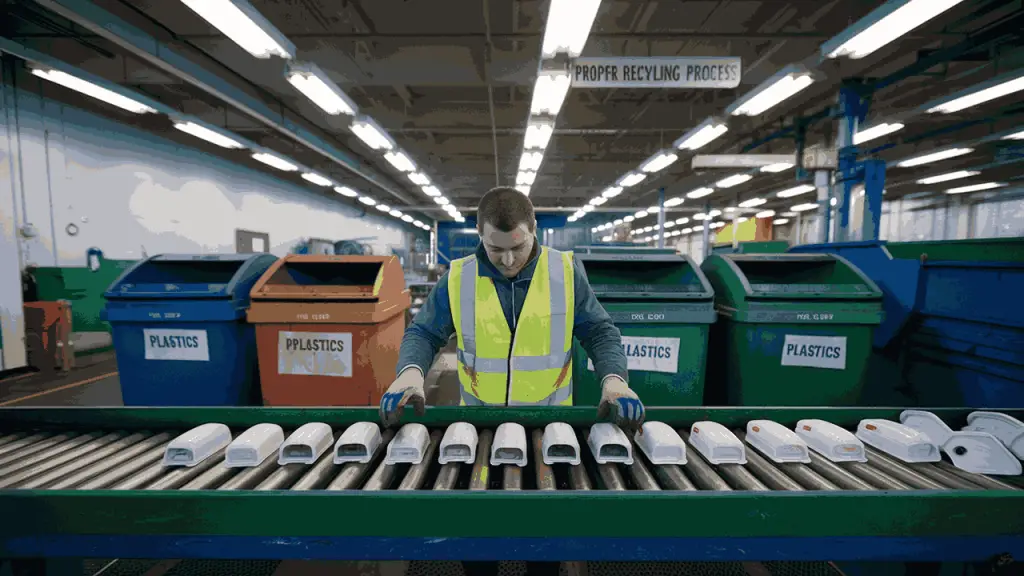
Now that we’ve explored the challenges in recycling clamshell plastic, let’s move on to the proper recycling process for these containers.
Understanding the correct steps can significantly improve recycling efficiency and reduce environmental impact.
A. Cleaning and preparation steps
Before recycling your clamshell containers, it’s crucial to prepare them properly:
- Rinse the containers thoroughly to remove any food residue
- Remove any labels or adhesives
- Ensure the plastic is completely dry
- Check for any non-plastic components and remove them
By following these steps, you’ll help prevent contamination and improve the quality of recycled materials.
B. Correct disposal methods
To ensure your clamshell plastics are recycled effectively:
- Check with your local recycling program to confirm if they accept clamshells
- If accepted, place clean and dry clamshells in your recycling bin
- If not accepted, look for alternative recycling solutions in your area
- Avoid putting clamshells in regular trash when possible
Got more plastics piling up? Check out How to Recycle Plastic Containers [9 Easy Steps To Follow] for some super easy tips!
Remember, not all recycling programs accept clamshells due to processing challenges. If your local program doesn’t accept them, consider reaching out to specialized recycling services like Ridwell, which has successfully diverted over 112,000 pounds of clamshells from landfills.
C. Processing at recycling centers
Once your clamshells reach a recycling center, they undergo a specific process:
| Step | Description |
| 1. Sorting | Clamshells are separated from other plastics |
| 2. Grinding | Containers are shredded into small pieces |
| 3. Washing | Shredded plastic is cleaned to remove impurities |
| 4. Melting | Clean plastic is melted down |
| 5. Pelletizing | Melted plastic is formed into pellets for reuse |
It’s important to note that clamshells present unique challenges during processing. Their lightweight nature can cause them to behave like paper on sorting conveyor belts, complicating the sorting process.
Additionally, the differences in manufacturing processes between clamshells and other PET products can affect the quality of recycled materials.
With this understanding of the proper recycling process for clamshells, you’re better equipped to contribute to sustainable packaging practices.
Next, we’ll explore the environmental impact of recycling clamshells, highlighting the importance of these efforts in reducing plastic waste and promoting a more sustainable future.
Environmental Impact of Recycling Clamshells
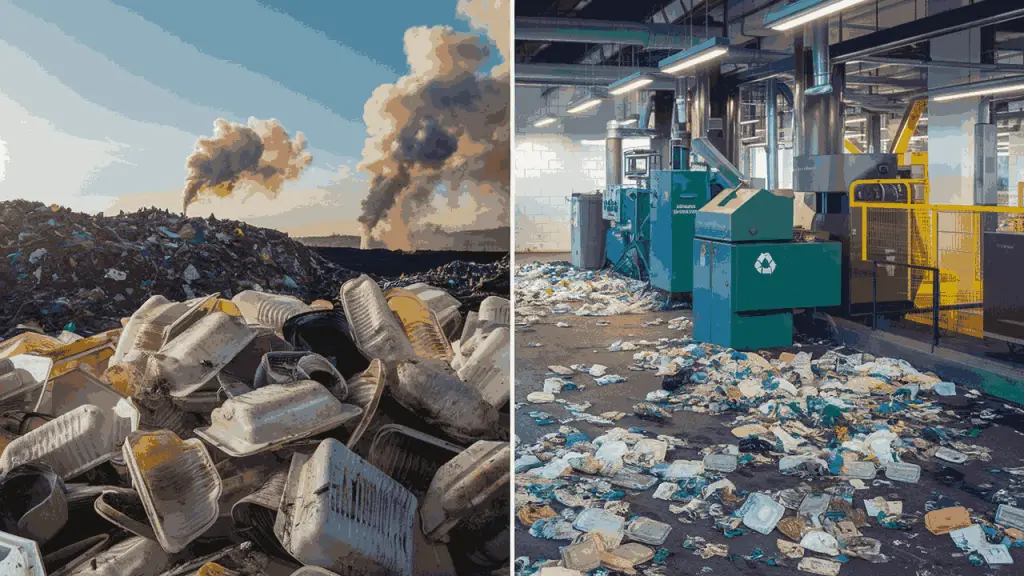
A. Energy savings
Recycling clamshells saves energy compared to producing new plastic. You’re helping conserve resources by choosing to recycle.
B. Reduction in CO2 emissions
Your decision to recycle clamshells reduces carbon dioxide emissions, contributing to the fight against climate change.
C. Water conservation
| Aspect | Impact |
| Water Usage | Recycling uses less water than manufacturing new plastic |
| Conservation | You help preserve water resources for other essential needs |
Identifying Recyclable Clamshells
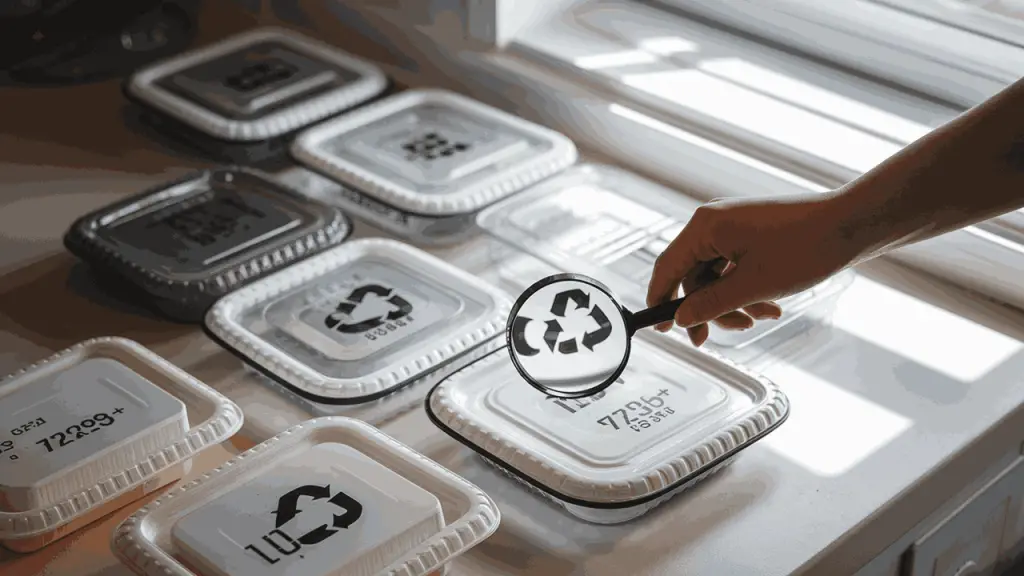
Now that we’ve explored the environmental impact of recycling clamshells, let’s focus on how you can identify recyclable ones.
A. Look for recycle symbol #1
You should check for the recycle symbol #1, which indicates PET or PETE plastic. This symbol is crucial for proper recycling.
B. Check for clear and smooth appearance
Recyclable clamshells typically have a clear, smooth appearance with slight flexibility. This characteristic helps in the sorting process.
C. Listen for a crinkly sound when squeezed
When you squeeze the clamshell, listen for a crinkly sound. This audible clue can help you distinguish recyclable clamshells from other plastics.
| Feature | Indication |
| Symbol #1 | PET/PETE plastic |
| Clear appearance | Likely recyclable |
| Crinkly sound | Potential recyclability |
Alternative Recycling Solutions
Now we’ll explore alternative recycling solutions for these challenging materials.
A. Specialized collection services
You can turn to specialized collection services like Ridwell for recycling clamshells. These services collaborate directly with PET recyclers, ensuring proper recycling without contamination.
By collecting clamshells separately, they transform them into post-consumer resin for new plastic products, promoting a circular economy.
B. Partnerships with sustainable recycling companies
| Company | Service Offered |
| K&S Recycling | Diverting materials from landfills |
| Ridwell | Specialized clamshell collection |
You can benefit from partnerships between recycling companies and collection services. These collaborations enhance recycling programs for businesses and individuals, focusing on plastics and other commodities.
C. Costs associated with specialized recycling
Specialized recycling services often come with a cost. For example, some services charge $4 per bag or $10 for five bags purchased in advance.
These fees cover operational expenses related to collection and recycling. While there’s a cost involved, it’s a small price to pay for reducing your environmental impact.
Consumer Actions for Sustainable Packaging
Now that we’ve explored alternative recycling solutions, let’s focus on how you can take action for sustainable packaging:
A. Avoid purchasing products with clamshell packaging
Choose items with minimal or recyclable packaging to reduce plastic waste.
B. Communicate concerns to manufacturers
Voice your desire for sustainable options to companies using clamshells.
C. Support companies committed to improving packaging sustainability
| Action | Impact |
| Buy from eco-conscious brands | Encourages sustainable practices |
| Choose products with PET or PLA packaging | Supports recyclable and biodegradable materials |
| Look for packaging with PCR content | Promotes circular economy in manufacturing |
Your choices can drive industry change towards greener packaging solutions.

